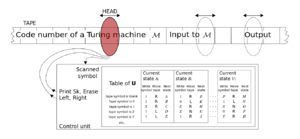Universal Turing machine (nonfiction): Difference between revisions
No edit summary |
|||
| Line 14: | Line 14: | ||
In terms of [[computational complexity]], a multi-tape universal Turing machine need only be slower by logarithmic factor compared to the machines it simulates. | In terms of [[computational complexity]], a multi-tape universal Turing machine need only be slower by logarithmic factor compared to the machines it simulates. | ||
== Fiction cross-reference == | |||
<gallery mode="traditional"> | |||
File:Thought camera.jpg|link=Scrying engine|Many [[Scrying engine|scrying engines]] behave according to Universal Turing machine principles. | |||
</gallery> | |||
* [[Gnomon algorithm]] - a mathematical function which converts computation to force. | |||
* [[Scrying engine]] - closely related to Universal Turing machines. | |||
== Nonfiction cross-reference == | == Nonfiction cross-reference == | ||
<gallery mode="traditional"> | |||
File:Alan_Turing_az_1930-as_években.jpg|[[|Alan Turing (nonfiction)|Alan Turing]] (1930s). | |||
</gallery> | |||
* [[Algorithm (nonfiction)]] | * [[Algorithm (nonfiction)]] | ||
| Line 21: | Line 34: | ||
* [[Computer science (nonfiction)]] | * [[Computer science (nonfiction)]] | ||
* [[Mathematics (nonfiction)]] | * [[Mathematics (nonfiction)]] | ||
== External links == | == External links == | ||
Revision as of 05:48, 13 June 2016

In computer science, a Universal Turing machine (UTM) is a Turing machine that can simulate an arbitrary Turing machine on arbitrary input.
Description
The universal machine essentially achieves this by reading both the description of the machine to be simulated as well as the input thereof from its own tape.
Alan Turing introduced this machine in 1936–1937.
This model is considered by some (for example, Martin Davis (2000)) to be the origin of the stored program computer—used by John von Neumann (1946) for the "Electronic Computing Instrument" that now bears von Neumann's name: the von Neumann architecture.
It is also known as universal computing machine, universal machine (UM), machine U, U.
Computational complexity
In terms of computational complexity, a multi-tape universal Turing machine need only be slower by logarithmic factor compared to the machines it simulates.
Fiction cross-reference
Many scrying engines behave according to Universal Turing machine principles.
- Gnomon algorithm - a mathematical function which converts computation to force.
- Scrying engine - closely related to Universal Turing machines.
Nonfiction cross-reference
- Algorithm (nonfiction)
- Computational complexity (nonfiction)
- Computer science (nonfiction)
- Mathematics (nonfiction)
External links
- Universal Turing machine @ wiki.karljones.com
- Universal Turing machine @ Wikipedia

![Alan Turing]] (1930s).](/w/images/thumb/1/13/Alan_Turing_%281930s%29.jpg/93px-Alan_Turing_%281930s%29.jpg)